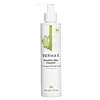What's inside
What's inside
 Key Ingredients
Key Ingredients

 Benefits
Benefits

 Concerns
Concerns

No concerns
 Ingredients Side-by-side
Ingredients Side-by-side

Water
Skin ConditioningGlycerin
HumectantPropanediol
SolventStearyl Alcohol
EmollientDecyl Glucoside
CleansingPanthenol
Skin ConditioningPinus Pinaster Bark Extract
AntioxidantAllantoin
Skin ConditioningCamellia Sinensis Leaf Extract 0.1%
AntimicrobialAloe Barbadensis Leaf Extract 0.1%
EmollientChamomilla Recutita Flower Extract 0.1%
MaskingCymbopogon Schoenanthus Extract 0.1%
Skin ConditioningXanthan Gum
EmulsifyingGlyceryl Stearate Citrate
EmollientPotassium Sorbate
PreservativePhenoxyethanol
PreservativeEthylhexylglycerin
Skin ConditioningWater, Glycerin, Propanediol, Stearyl Alcohol, Decyl Glucoside, Panthenol, Pinus Pinaster Bark Extract, Allantoin, Camellia Sinensis Leaf Extract 0.1%, Aloe Barbadensis Leaf Extract 0.1%, Chamomilla Recutita Flower Extract 0.1%, Cymbopogon Schoenanthus Extract 0.1%, Xanthan Gum, Glyceryl Stearate Citrate, Potassium Sorbate, Phenoxyethanol, Ethylhexylglycerin
Water
Skin ConditioningPropanediol
SolventGlycerin
HumectantSodium Ascorbyl Phosphate
AntioxidantLactic Acid
BufferingSodium Lactate
BufferingPolyglyceryl-6 Caprate
CleansingPolyglyceryl-3 Cocoate
EmulsifyingPolyglyceryl-3 Caprate
EmulsifyingPolyglyceryl-6 Ricinoleate
EmulsifyingAloe Barbadensis Leaf Juice
Skin ConditioningPanthenol
Skin ConditioningSodium Anisate
AntimicrobialSodium Levulinate
Skin ConditioningGlyceryl Caprylate
EmollientChamomilla Recutita Flower Extract
MaskingPunica Granatum Seed Extract
Skin ConditioningPrunus Armeniaca Kernel Oil
MaskingTocopherol
AntioxidantXanthan Gum
EmulsifyingCamellia Sinensis Leaf Extract
AntimicrobialWater, Propanediol, Glycerin, Sodium Ascorbyl Phosphate, Lactic Acid, Sodium Lactate, Polyglyceryl-6 Caprate, Polyglyceryl-3 Cocoate, Polyglyceryl-3 Caprate, Polyglyceryl-6 Ricinoleate, Aloe Barbadensis Leaf Juice, Panthenol, Sodium Anisate, Sodium Levulinate, Glyceryl Caprylate, Chamomilla Recutita Flower Extract, Punica Granatum Seed Extract, Prunus Armeniaca Kernel Oil, Tocopherol, Xanthan Gum, Camellia Sinensis Leaf Extract
 Reviews
Reviews

Ingredients Explained
These ingredients are found in both products.
Ingredients higher up in an ingredient list are typically present in a larger amount.
Camellia Sinensis Leaf Extract is derived from the leaves of the tea plant. Black tea, green tea, and oolong tea are all harvested from this plant.
This ingredient has many skin benefits:
This ingredient contains polyphenols, a strong antioxidant. Antioxidants help fight off molecules that damage skin cells.
On top of that, the antioxidants in green tea neutralize free-radicals from the sun. This gives the skin some extra UV protection, but should not replace sunscreen.
Many components of tea have anti-inflammatory properties.
Polyphenols and L-theanine help soothe the skin and reduce irritation. The caffeine in Camellia Sinensis Leaf Extract helps calm inflamed blood vessels.
Other compounds found in tea include: Vitamin Bs, linoleic acid, magnesium, calcium, iron, and zinc.
Research has shown both drinking Camellia Sinensis Leaf Tea and applying it to the skin can help boost skin elasticity and hydration. Studies also show using tea extract may reduce sebum, or oil, production.
Learn more about Camellia Sinensis Leaf ExtractChamomilla Recutita Flower Extract comes from the Chamomile flower.
Chamomile is rich in antioxidants and has anti-inflammatory properties. Several compounds found in chamomile help with soothing, such as bisbolol.
Antioxidant components in chamomile make it an effective ingredient to help slow the signs of aging. Antioxidants help fight free-radical molecules, or molecules that may damage your skin.
Essential oils from chamomile have been found to improve wound healing due to its antimicrobial properties.
Ancient Greeks and Egyptians used Chamomile to treat skin redness and dryness. Chamomile has also been used to help treat stomach issues.
Learn more about Chamomilla Recutita Flower ExtractGlycerin is already naturally found in your skin. It helps moisturize and protect your skin.
A study from 2016 found glycerin to be more effective as a humectant than AHAs and hyaluronic acid.
As a humectant, it helps the skin stay hydrated by pulling moisture to your skin. The low molecular weight of glycerin allows it to pull moisture into the deeper layers of your skin.
Hydrated skin improves your skin barrier; Your skin barrier helps protect against irritants and bacteria.
Glycerin has also been found to have antimicrobial and antiviral properties. Due to these properties, glycerin is often used in wound and burn treatments.
In cosmetics, glycerin is usually derived from plants such as soybean or palm. However, it can also be sourced from animals, such as tallow or animal fat.
This ingredient is organic, colorless, odorless, and non-toxic.
Glycerin is the name for this ingredient in American English. British English uses Glycerol/Glycerine.
Learn more about GlycerinPanthenol is a common ingredient that helps hydrate and soothe the skin. It is found naturally in our skin and hair.
There are two forms of panthenol: D and L.
D-panthenol is also known as dexpanthenol. Most cosmetics use dexpanthenol or a mixture of D and L-panthenol.
Panthenol is famous due to its ability to go deeper into the skin's layers. Using this ingredient has numerous pros (and no cons):
Like hyaluronic acid, panthenol is a humectant. Humectants are able to bind and hold large amounts of water to keep skin hydrated.
This ingredient works well for wound healing. It works by increasing tissue in the wound and helps close open wounds.
Once oxidized, panthenol converts to pantothenic acid. Panthothenic acid is found in all living cells.
This ingredient is also referred to as pro-vitamin B5.
Learn more about PanthenolPropanediol is an all-star ingredient. It softens, hydrates, and smooths the skin.
It’s often used to:
Propanediol is not likely to cause sensitivity and considered safe to use. It is derived from corn or petroleum with a clear color and no scent.
Learn more about PropanediolWater. It's the most common cosmetic ingredient of all. You'll usually see it at the top of ingredient lists, meaning that it makes up the largest part of the product.
So why is it so popular? Water most often acts as a solvent - this means that it helps dissolve other ingredients into the formulation.
You'll also recognize water as that liquid we all need to stay alive. If you see this, drink a glass of water. Stay hydrated!
Learn more about WaterXanthan gum is used as a stabilizer and thickener within cosmetic products. It helps give products a sticky, thick feeling - preventing them from being too runny.
On the technical side of things, xanthan gum is a polysaccharide - a combination consisting of multiple sugar molecules bonded together.
Xanthan gum is a pretty common and great ingredient. It is a natural, non-toxic, non-irritating ingredient that is also commonly used in food products.
Learn more about Xanthan Gum